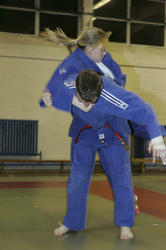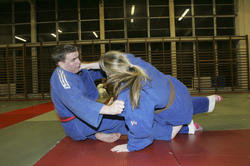History of Judo
History of Judo
Jujitsu is the source of modern Judo. Medieval Japanese Warriors practiced many forms of unarmed combat, which were grouped under the general name "Jujitsu" for "the gentle practice." The object of all these martial arts forms was to avoid an enemy's superior strength and to use that strength to his disadvantage. Since Jujitsu was strictly a combat technique, contests were rare and were decided only by the death or crippling of one of the contestants.
When Japanese society began to change structurally in the 1860's, feudal lords no longer had their private armies; the martial arts, including Jujitsu, began to die out. In the early 1880's, Professor Jigoro Kano, a teacher from Tokyo and an expert in many types of Jujitsu, decided to save some of these ancient knowledges. He modified or eliminated the most dangerous of the Jujitsu techniques and created a new discipline, which he called "Judo" or "the gentle way."
Judo is "the gentle way" because the end result is the accomplishment of a goal with maximum effieciency and minimum effort. As a sport, rather than simply a combat form, Judo includes a code of sportsmanship, a sense of mutual respect, and a system of ethical and moral development. Judo is both an art and a science. As an art, Judo enables its practitioners to gain self-respect, self-confidence, and self-expression; as a science, it involves a mastery of such basic natural laws as gravity, friction, momentum, weight transmission, and unity of forces. From its simple beginnings in nineteenth-century Japan, Judo has spread in popularity throughout the world. Its rich, medieval heritage combined with Professor Kano's modern, scientific approach has made Judo into the exciting sport it is today.
Professor Jigoro Kano |
Judo and WWII The aftermath of the 2nd World War was a dark era for Japan and things Japanese. As part of Japan's war effort, instructors had been ordered to teach unarmed combat. In retaliation the occupation forces prohibited all practice of the martial arts in schools and public institutions. The ban remained in place until 1951 although there had been a gradual relaxation of the rule. Private instruction in judo was tolerated and the police were excepted from the general prohibition. The Kodokan was largely left to reestablish itself unhindered. Kano had taken a stand against the worst aspects of militarism in pre-war Japan and that, together with new draft rules which removed the vestiges of judo's martial origin made Kodokan judo acceptable to the authorities. In 1949 the occupation authorities indicated that the yudanshakai (dan grade society) of the various schools could be reconstituted as a single democratic organization. As a result the Japanese Judo Federation was formed under the presidency of Risei Kano, only son of Jigoro Kano, with headquarters at the Kodokan. Today the All Japan Judo Federation has Jigoro Kano's grandson as its President. |
Judo in Britain With the intention of establishing a ju-jutsu school in England, Mr E W Barton Wright sponsored a visit in 1899 of a team of Japanese judo experts. The project failed but those who stayed took to the stage to earn a living. Best known among them was Yukio Tani, who toured music halls offering challengers £1 per minute for every minute they lasted beyond five and£50 if they defeated him. The prize money was rarely (if ever) paid. Over the following decade or so many Japanese "showmen" performed on stages around the country performing frivolous tricks linked with ju-jutsu. For all their showmanship, these men were very capable ju-jutsu players. Their real contribution to the growth of judo outside Japan was made in the books they published and the instruction they gave. Tani remained in England after his compatriots had returned home and in 1920 was formally appointed chief instructor to a new club for "the study of systems developed by the samurai":the Budokwai. Neither he nor the club's founder Gunji Koizumi, could have foreseen that they were creating an institution soon to become the most famous judo school outside Japan. |
Y Tani demonstrates a |
Britain's first Judo Club Tuition was given in judo, kendo (swordsmanship) and other aspects of Japanese culture; Tani continued as instructor until a stroke forced him to retire in 1937. Koizumi was to European judo what Kano was to world judo. He first came to Britain in 1906 and after a few years in the USA he returned to open the Budokwai as a cultural centre and social club for the Japanese community in London. The official opening took place on 26 January 1918 and within 4 months the membership had grown to 44 including 2 Englishmen. The Budokwai educated several generations of judo men at a time when genuine judo clubs were few and far between. For many years it was the only authoritative source of Kodokan judo in Europe. The link had been forged by Jigoro Kano during an extended visit to Britain in 1920. The British Judo Association Koizumi's vision for the growth of judo on an international basis began to materialize in 1948. On 24 July that year the British Judo Association (BJA) was established as the representative national body; four days later a meeting under the chairmanship of Trevor Leggett, the most senior non-Japanese player in the world, approved the constitution of a European Judo Union (EJU) to represent judo in the continent of Europe. Three years later still, the International Judo Federation (IJF) was created as an inter-continental body with overall control of judo. Judo and the "rest of the World" Judo entered many countries from 1902 to the 1930's. In the United States judo gained an early foothold because of the interest shown by President Theodore Roosevelt. As an expression of goodwill Kano sent Yoshiaki Yamashita, a high ranking member of the Kodokan, to America in 1902 to be his personal instructor. Roosevelt trained regularly , if clumsily and in due course a room was set aside at the White House for judo purposes. It was thirty-odd years, however, before an American reached dan grade in the USA itself. Clubs were set up in Seattle in 1903 and Los Angeles in 1915. Brisbane Judo Club was the first founded in Australia in 1928 by DR A J Ross, a Kodokan dan grade. Judo later reached New Zealand via Australia in 1948 when G Grundy, a 2nd Dan from the Budokwai, opened a club in Auckland. The most successful "newcomer" so to speak is the USSR. Strictly speaking a form of judo has been practised in the Soviet Union since about 1930. The Russians practice a wrestling system called Sambo. This is a synthesis of many different wrestling systems, however because of the absence of international competition outside of the USSR, the Russians turned their attention to judo. In 1962 a Soviet judo team comprising Sambo men in judo suits collected five medals at the European Judo Championships. Sambo is a close cousin of judo, but it lacks the same conceptual framework. It can be seen as an implied compliment that the Russians have stepped up considerably the emphasis on judo during recent years. |
.




